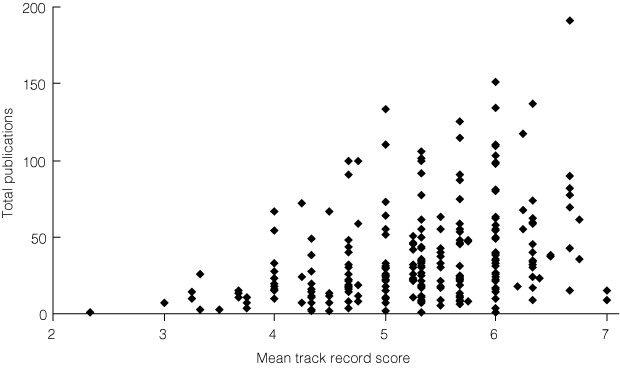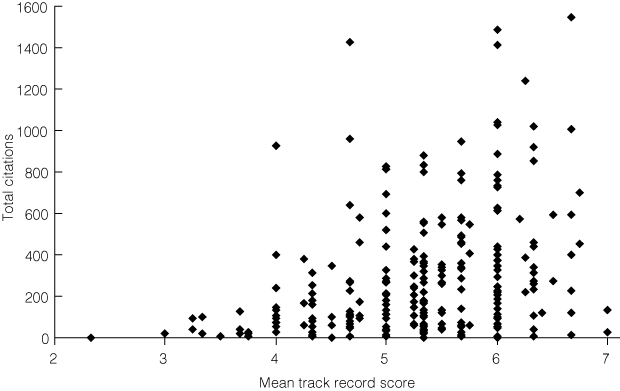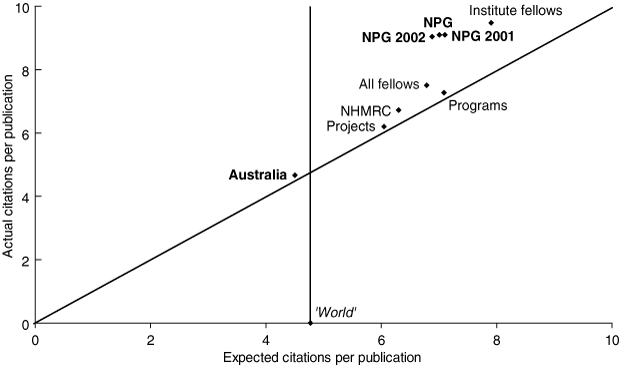In assessing project grant applications, the NHMRC uses a system of anonymous peer review, with assessors’ scores providing a guide to committees in priority ranking of all applications, which effectively determines which applications are funded. One part of the assessment is the allocation of a “track record” score based on the research publication output of the project’s investigators during the preceding 6 years (Box 1).
In 2001, the NHMRC initiated a revised program grants scheme. The scheme aims to provide support for research teams to pursue broadly based collaborative activity, and grants are typically of 5 years’ duration. Inter alia, the teams are expected to contribute knowledge at a leading international level and tackle problems for which longer-term stable funding is essential. In 2001, 60% of the program grant assessment was based on the record of research achievement, with 35% of the total score relating to the applicants’ publications (Box 1).
The first step was to identify the publications that formed the basis on which assessors made their judgements. In the case of project grants, this referred to articles published by the investigators in the 6-year period preceding the grant application. For investigators listed on successful program grant applications, we restricted our publication coverage to articles published in the 5-year period 1996–2000, to make it directly comparable with a 2003 study of the publication impact of NHMRC-funded publications.2
Citation analyses were undertaken on the final publication sets. For project grants, we then compared the bibliometric measures with assessors’ track record scores to determine the extent of the relationship. A maximum correlation coefficient of “1” indicated a perfectly linear relationship between the two variables, while a coefficient of “0” indicated no relationship at all. In the case of program grants, the results of citation analysis were compared with data reported in the 2003 bibliometric study.2
Total publications. This was the total number of ISI-indexed articles published by all investigators over the relevant 6-year period.
Total citations. This was the total number of all citations to the applicants’ articles received during the same period.
Total journal impact. This is the sum of the average citation rates for all journals in which the applicants’ articles appeared. The ISI journal impact factor is commonly used to assess the prestige of a journal, but it suffers from a number of methodological problems.3 The measure we used is more robust, as it is based on a longer time frame — the same period covered by our analysis.
Citations per publication. To allow for differences in the number of researchers listed on grant applications, total citations were size-adjusted by calculating an average per publication.
Average journal impact. As for the previous measure, a size-adjusted figure was calculated to arrive at an average citation rate for journals in which the applicants’ articles appeared.
Field-normalised citations per publication. To ensure our results were not affected by field-specific citation characteristics, we calculated citation rates adjusted for the average world rate in the discipline.
Field-normalised average journal impact. As for the previous measure, we calculated field-normalised journal impact data.
The initial correlations were carried out between mean track record scores and two simple bibliometric measures — total publications and total citations. The correlations were undertaken separately for each cohort, as the publication period (and hence the citation period) differed, and we sought to remove this possible source of data “noise”. The correlation coefficients for the 2000 data were 0.389 for total publications and 0.430 for total citations; the coefficients for the 2001 data were 0.375 and 0.327, respectively. Scatter plots of the 2001 data are presented in Box 2 and Box 3. These plots show that a large number of grant applications with low publication and/or citation counts had been given high track record scores (ie, > 5). These unexpected results led us to increase our initial sample from 10% to 15%, but, even with a larger sample, the results remained unchanged.
In attempting to identify any underlying causes for the poor correlation between track record scores and bibliometric measures, we compared successful and unsuccessful grants and looked at the level of agreement between assessors (as indicated by the SD of the assessors’ scores). Nearly all bibliometric variables remained weakly correlated, if at all, with the track record scores, and no correlations were statistically significant. The data from individual panels were also examined. Correlation coefficients based on four bibliometric measures for the 2001 cohort are shown in Box 4. This analysis was limited to the five panels for which robust publication counts existed.
There were considerable differences in the results across panels. High correlations were apparent for only two panels: for the immunology panel, there were strong correlations across all measures; for the endocrinology/reproduction panel, it was the publication and citation counts, unadjusted for size, that showed the strongest correlations. For the microbiology and public health panels, correlations were either extremely low or completely absent (Box 4).
We undertook further analysis to examine in detail the outliers depicted in Box 2 and Box 3. We investigated applications for which assessors had given a score of 6 or more, but for which we found < 50 publications and/or < 500 citations. We also examined applications that had been given scores of less than 5, but were above the benchmarks of 50 publications and/or 500 citations. This investigation shed little further light on the reasons for low correlations.
In analysing project grants, we anticipated strong correlation between track record scores and bibliometric measures, as other studies have shown strong correlation between peer assessment and bibliometric analysis, even when the assessment took into account factors beyond the body of published research.4,5 We expected that high track record scores would be primarily associated with grants with high publication and citation counts, but our results did not reflect this.
Studies such as those by Oppenheim4 and Aksnes and Taxt6 have shown much stronger correlations between bibliometric indicators and peer review rankings, with coefficients of 0.7 or better. Yet the rankings to which they were relating their measures were generally based on a much wider remit — the “quality” of the units of assessment — rather than the much more specific focus of the track record assessments we were using. As our bibliometric indicators were direct measures of the published criteria for track record scores, we expected the correlations in our study to be even stronger.
The considerable differences in results across panels may in part explain the poor level of correlation. For example, ISI citation index coverage of the publication output in the area of public health is relatively poor, and much of the output is found in other formats.7 Weaker correlations were therefore expected for this discipline — although not the complete absence of association that we found. On the other hand, the lack of correlation in the data for the microbiology panel was unexpected and counterintuitive. As journals in this discipline are comprehensively covered by ISI indexes, bibliometric data should have correlated strongly with the scores based on the selection criteria (Box 1). Differences in ISI coverage between different grant review panels does not provide the complete answer to the poor correlations. This result raises the possibility that assessors deviated from the scoring criteria in providing track record scores.
In contrast to the perplexing outcomes of our analysis of project grants, the results for program grants were in line with our expectations. Previous studies of NHMRC-supported research2,8 have shown that the block-funded institutes, and research fellows located in these institutes, have a citation impact well above that of other NHMRC funding schemes and other Australian research sectors. Thus, given the standing of researchers targeted by the program grants scheme and the substantial weight given to publications in the assessment criteria, we anticipated that successful applicants would have a very strong citation record. Our results confirmed this.
As the track record score is only a single component of a much larger peer review process for project grant applications, the identified lack of correlation between track record scores and bibliometric measures in project grant applications cannot be used to question the validity of the final outcomes of the application process. The assessors do appear to “get it right”: the 2003 bibliometric study of NHMRC-funded research found that research projects funded by the NHMRC performed at a much higher level than those undertaken without NHMRC support, and their performance was above world and Australian benchmarks.2
In a study of grant proposals to the US National Science Foundation, Abrams identified two possible reasons for similar low correlations.9 He suggested that “the ability to produce a highly-rated proposal inherently has little correlation with the ability to carry out and publish high quality research”. He also suggested that the limited time scientists can devote to evaluating proposals can introduce considerable uncertainty into the process.
Perhaps now is the time to develop a more automated system of track record assessment. Why ask peers to assess track records from scratch, when there are defensible surrogates for this aspect of the grant application? Surely their scarce time is best reserved for where it is most useful, and where no alternative is possible — assessing the significance, approach and feasibility of applications. They could be relieved of the burden of assessing track record, only delving into it in the relatively few cases in which there are concerns about the automatically generated scores. Concerns about the use of such measures, raised recently in an article by Lehmann et al,10 related not to the measures themselves, but to their potential “harmful misuse”. Bibliometrics has progressed significantly in recent years, and measures are now available that are sensitive to field-specific characteristics and the concerns of researchers who are at an early stage of their careers.
2 Comparison of mean track record scores with total publications for project grant applications in 2001*
 | |||||||||||||||
3 Comparison of mean track record scores with total citations for project grant applications in 2001*
 | |||||||||||||||
4 Correlation coefficients of bibliometric measures and track record scores, selected 2001 project grant review panels
Received 9 January 2007, accepted 19 June 2007
- Marcus B Nicol1
- Kumara Henadeera2
- Linda Butler2
- 1 Clinical Trials, National Stroke Research Institute, Melbourne, VIC.
- 2 Research Evaluation and Policy Project, Australian National University, Canberra, ACT.
Our thanks go to Roland Wise and David Porter at the NHMRC for their cheerful assistance in extracting and providing data from NHMRC records, and to Tim Brown for his advice with the statistical analysis. Certain data included here are derived from the Australian National Citation Report prepared by the Institute for Scientific Information, Philadelphia, Pa, USA. (Copyright ISI, 2000. All rights reserved.)
Marcus Nicol has been a consultant for the NHMRC for the past 4 years. The raw data collected for our article was part of a previous consultancy contract; however, the design, analysis and drafting of the article was not part of any paid consultancy with the NHMRC, and was done purely for academic interest.
- 1. National Health and Medical Research Council. Record of Research Achievement (RORA) — qualitative grid. http://www.nhmrc.gov.au/funding/apply/granttype/programs/_files/rora_grid.xls (accessed Jun 2007).
- 2. Butler L. NHMRC-supported research: the impact of journal publication output. Canberra: National Health and Medical Research Council, 2003: 75. http://www.nhmrc.gov.au/publications/synopses/_files/butler03.pdf (accessed Jun 2007).
- 3. Moed H. The impact-factors debate: the ISI’s uses and limits. Nature 2002; 415: 731-732.
- 4. Oppenheim C. The correlation between citation counts and the 1992 research assessment exercise ratings for British research in genetics, anatomy and archaeology. J Doc 1997; 53: 477-487.
- 5. Bornmann L, Daniel H. Reliability, fairness and predictive validity of committee peer review. BIF Futura 2004; 19: 7-19. http://www.bifonds. de/public/news/bornmann_e.pdf (accessed Jul 2007).
- 6. Aksnes DW, Taxt RE. Peer review and bibliometric indicators: a comparative study at a Norwegian university. Res Eval 2004; 13: 33-41.
- 7. Butler L, Biglia B, Henadeera K. NHMRC-supported research: the impact of journal publication output 1999–2003. Canberra: National Health and Medical Research Council, 2006. http://www.nhmrc.gov.au/publications/synopses/_files/nh75.pdf (accessed Jul 2007).
- 8. Butler L, Biglia B. Analysing the journal output of NHMRC research grants schemes. Canberra: National Health and Medical Research Council, 2001. http://www.nhmrc.gov.au/publications/synopses/_files/r21.pdf (accessed Jul 2007).
- 9. Abrams PA. The predictive ability of peer review of grant proposals: the case of ecology and the US National Science Foundation. Soc Stud Sci 1991; 21: 111-132.
- 10. Lehmann S, Jackson D, Lautrup B. Measures for measures. Nature 2006; 444: 1003-1004.






Abstract
Objectives: To investigate the correlation between the publication “track record” score of applicants for National Health and Medical Research Council (NHMRC) project grants and bibliometric measures of the same publication output; and to compare the publication outputs of recipients of NHMRC program grants with those of recipients under other NHMRC grant schemes.
Design: For a 15% random sample of 2000 and 2001 project grant applications, applicants’ publication track record scores (assigned by grant assessors) were compared with bibliometric data relating to publications issued in the previous 6 years. Bibliometric measures included total publications, total citations, and citations per publication. The program grants scheme underwent a major revision in 2001 to better support broadly based collaborative research programs. For all successful 2001 and 2002 program grant applications, a citation analysis was undertaken, and the results were compared with citation data on NHMRC grant recipients from other funding schemes.
Main outcome measure: Correlation between publication track record scores and bibliometric indicators.
Results: The correlation between mean project-grant track record scores and all bibliometric indicators was poor and below statistically significant levels. Recipients of program grants had a strong citation record compared with recipients under other NHMRC funding schemes.
Conclusion: The poor correlation between track record scores and bibliometric measures for project grant applications suggests that factors other than publication history may influence the assignment of track record scores.